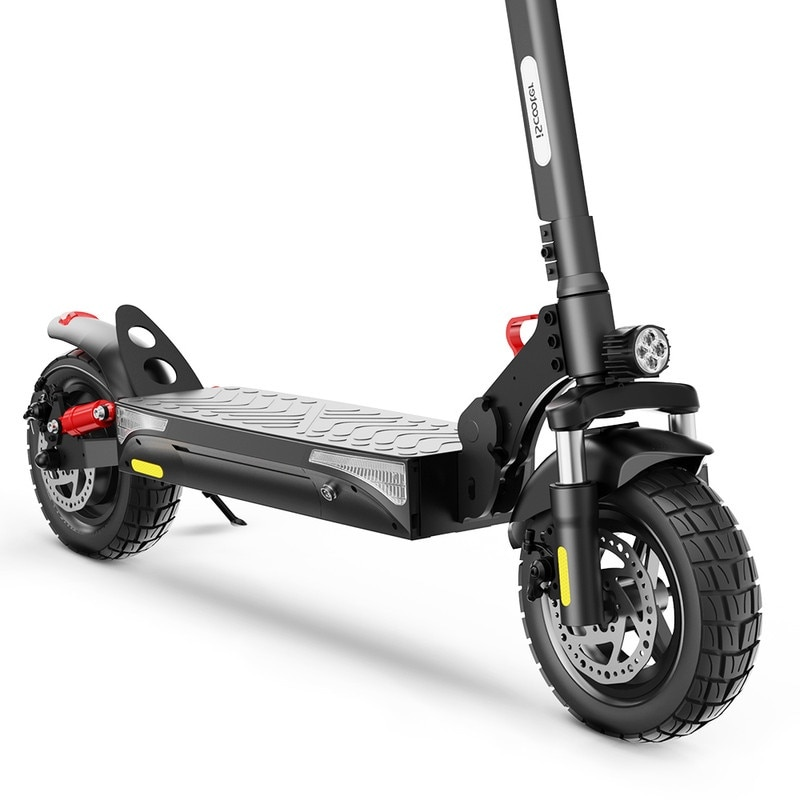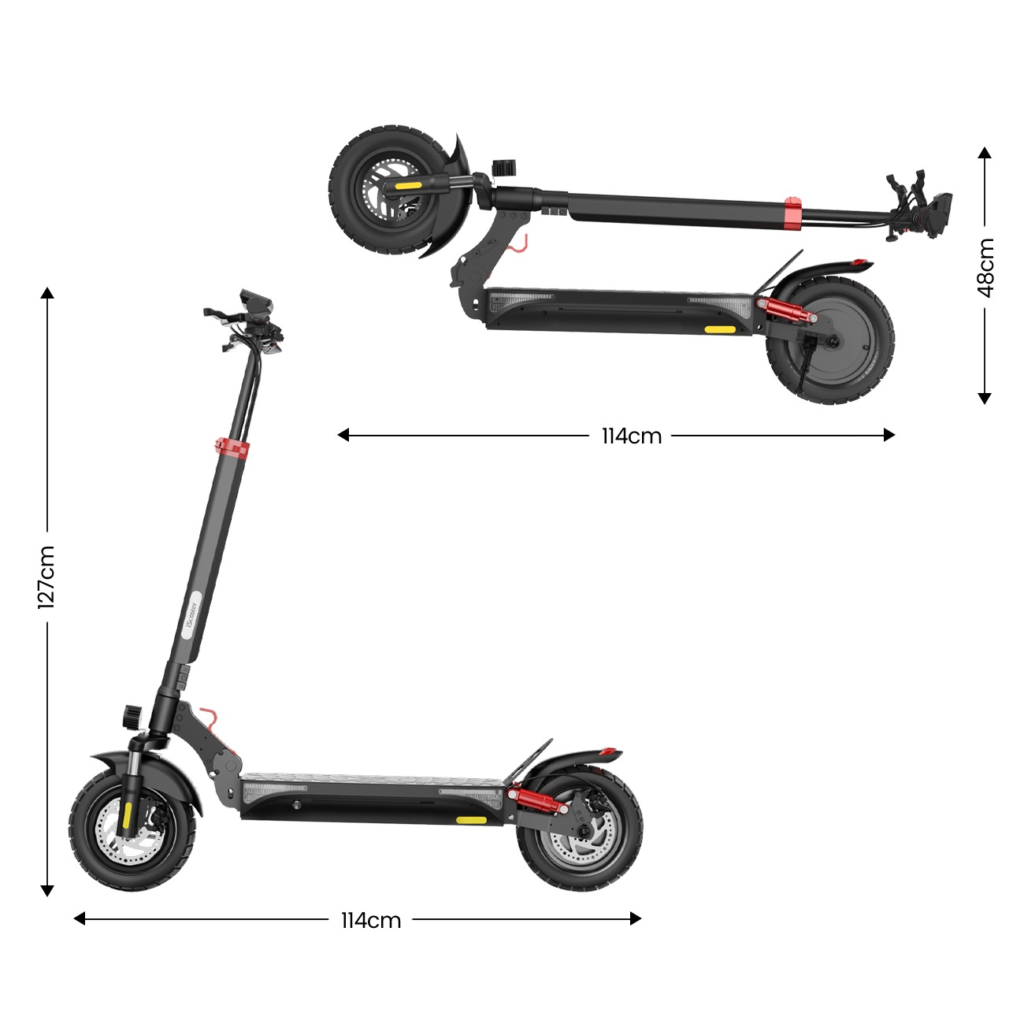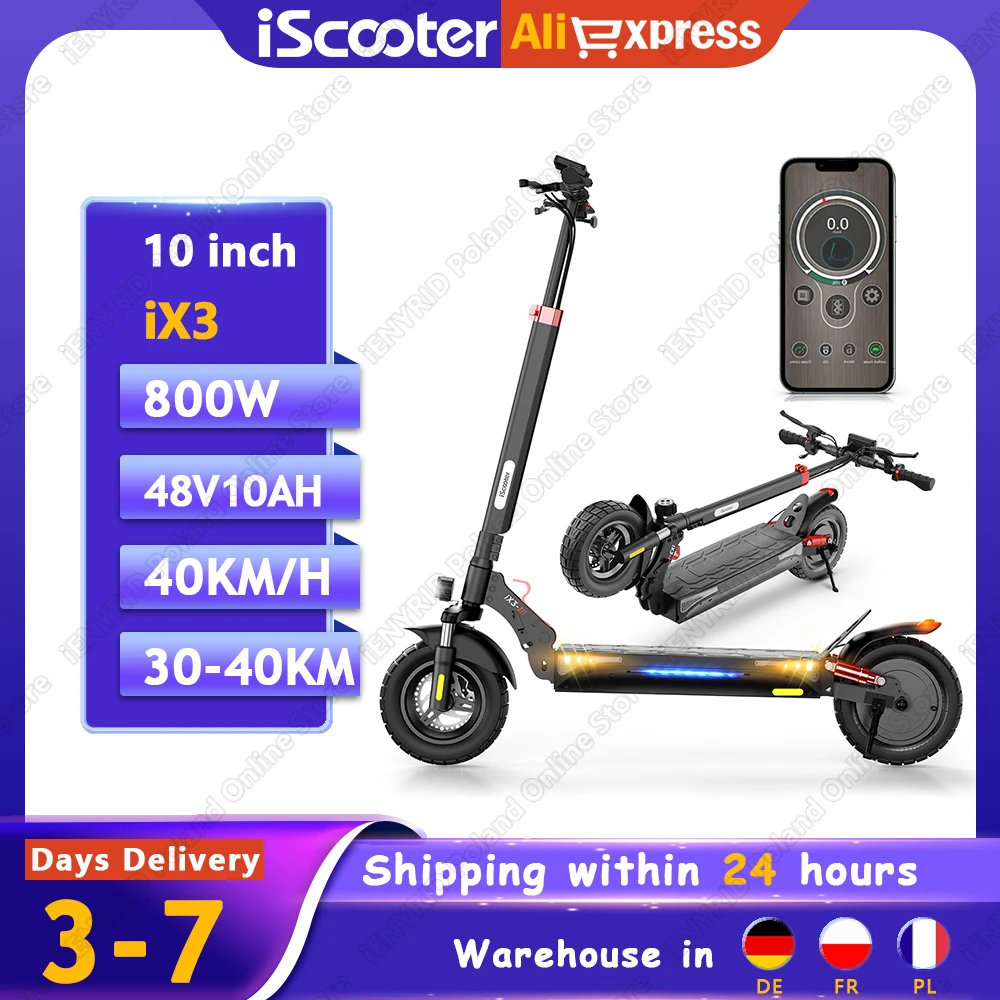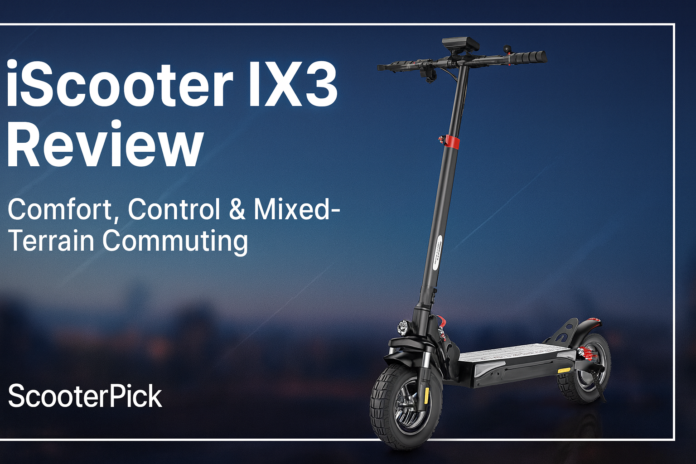The iScooter iX3 aims to be a rugged, affordable step-up for riders who want real off-road grip without giving up day-to-day usability. In this iScooter iX3 review, we take a deep, practical look at how it’s put together, how it rides, and where it shines or struggles in real commutes. If you’re considering the iScooter iX3 for mixed terrain or rougher city streets, this guide walks you through the details that matter before you click “buy.”
Key Specifications
| Block | Item | Details |
|---|---|---|
| General | Model | iScooter iX3 |
| Intended Use | Off-road-capable commuter / mixed-terrain riding | |
| Water Resistance | IPX4 | |
| Max Rider Weight | 264 lb (110 kg) | |
| Recommended Rider Age | 16+ | |
| Performance & Power | Motor | 800 W rear-hub |
| Top Speed | Up to 24 mph (40 km/h) | |
| Claimed Range | Up to 25 miles (40 km) per charge | |
| Climbing Angle | Up to 25° (short hill bursts) | |
| Charging & Electrical | Battery | 48 V, 10 Ah (lithium-ion) with BMS |
| Charging Time | ~6–7 hours | |
| Lights | Front LED headlight; rear LED; brake-light flash; turn signals; ambient lighting | |
| Build & Dimensions | Tires | 10-in (25.4 cm) off-road pneumatic |
| Suspension | Dual suspension: front and rear | |
| Unfolded Size | 47 × 23 × 50 in (120 × 65 × 128 cm) | |
| Folded Size | 47 × 8 × 19 in (120 × 20 × 50 cm) | |
| Weight | 52.2 lb (23.25 kg) | |
| Safety & Control | Brakes | Mechanical disc + electronic braking front and rear |
| Signals/Alert | Turn signals; electronic horn; certified E-MARK reflectors | |
| Features & Extras | Display | LED cockpit showing speed, battery, mode, lights, trip, indicators |
| App & Connectivity | Bluetooth app monitor; settings and modes | |
| Riding Modes | Eco / Drive / Sport (regional limits may apply) | |
| Cruise Control | Yes | |
| Folding | 3-step manual folding | |
| Warranty & Compliance | Warranty | 12-month limited warranty (manufacturer) |
| Compliance Notes | E-MARK reflectors; regional rules vary |
Design & Build Quality
Right out of the box, the iX3 reads as a purpose-built all-rounder. The stance is wide, the deck is long enough for staggered feet, and the bar controls are straightforward. Because the scooter uses 10-inch off-road pneumatic tires and dual suspension, it looks burlier than an entry-level commuter. Yet, it still folds to a compact slab that fits along a wall or in a car trunk.
Fit and finish are better than you’d expect at this tier. Cable routing is tidy, the lever throw on the mechanical discs is consistent, and the display is bright even in daylight. The signal lights sit high enough to be visible to traffic. Meanwhile, the mudguards have decent coverage, which helps in wet conditions. However, note the IPX4 rating: it resists splashes, not submersion or pressure-wash. Consequently, thoughtful storage and cautious wet-weather riding remain important.
The folding assembly uses a three-step latch that becomes second nature after a few tries. It feels solid when locked, and the stem flex under braking is minor. There’s still some flex, as with most mid-weight scooters, but nothing alarming in normal use. Finally, at 52.2 lb (23.25 kg) it isn’t ultralight. The trade-off is a chassis that feels composed when the surface gets choppy.

Motor, Power & Acceleration
The rear-hub 800 W motor gives the iX3 a predictable launch. It doesn’t blast out of the gate like dual-motor machines, yet it moves away from lights briskly and with control. Because power goes to the rear, traction on loose patches is more manageable. On clean tarmac, you can roll on the throttle without sudden wheelspin.
Acceleration remains linear up to cruising pace. Sport mode tightens the response, while Eco and Drive are gentler and better for crowded paths. On short hills, the scooter holds momentum well; on longer climbs it slows, yet it usually maintains an acceptable crawl without overheating. Riders near the 264 lb (110 kg) limit will feel more drop-off on steeper grades. However, that is expected in this power class and weight range.
Top speed up to 24 mph (40 km/h) is attainable on level ground for average-weight riders. For daily use, cruising 15–20 mph (24–32 km/h) feels smooth and stable, especially with those 10-inch tires. Notably, the app and onboard modes help cap speeds when you need extra safety or when local rules impose limits.
Battery, Range & Efficiency
The iX3 pairs a 48 V, 10 Ah pack with a conservative controller tune. This combination favors consistency and component life over bursty peak draws. In mild weather and on mostly flat routes, riders can expect a practical mid-teens to low-20s mile range (roughly 15–22 miles, 24–35 km) with mixed pacing. Heavier riders, faster cruising, cold temperatures, and hills will trim that. Conversely, smooth riding in Eco or Drive mode on warm days can stretch distance.
Because the battery is relatively modest, the scooter regains full charge in about 6–7 hours using the stock charger. That makes overnight top-offs convenient. The built-in battery management system (BMS) protects against common faults and supports longevity when paired with careful charging habits. For example, partial top-offs and avoiding storage at 100% for long periods can help.
The deck packaging balances ground clearance and battery volume reasonably well. You get enough space underfoot for a natural stance, without a tall deck that would raise your center of gravity on rough ground. That balance helps the iX3 feel planted yet nimble.

Ride Quality, Handling & Comfort
Ride quality is the iX3’s standout trait. The combination of 10-inch pneumatic off-road tires and dual suspension lets it float over broken asphalt and brick-lined paths. Expansion joints that jar smaller scooters become a muted thud here. Moreover, the suspension never feels bouncy when you stay within the intended speed range.
Steering is neutral. The wheelbase and deck length promote stability, especially at 15–20 mph (24–32 km/h). On loose gravel, the tires find steady grip, provided you avoid sudden inputs. In crowded bike lanes, the scooter tracks straight and responds predictably to small corrections. The deck’s usable width encourages staggered feet, which further calms the chassis at speed.
On steep, uneven paths, the rear-drive layout helps with traction. However, because this isn’t a dual-motor machine, you must plan your momentum. Approach short climbs with a small run-up when possible. On 7–8% grades, expect speed to taper, and be ready to switch to Sport mode.
Braking & Safety Features
Braking duties are shared between mechanical discs and an electronic assist at both ends. The levers offer a consistent bite point, and the e-brake adds a gentle drag that helps settle the chassis as you scrub speed. With practice, you can modulate for smooth stops in short distances without abrupt fork dive. On wet roads, the pneumatic tires and dual contacts make a difference; still, increase following gaps and brake earlier.
Lighting and signaling are robust for the category. The high-mounted headlight projects a usable beam for urban speeds, while the rear light flashes under braking. The integrated turn signals are a welcome upgrade at dusk and during group rides. Finally, the E-MARK reflectors add passive visibility from the sides and back. Pair these with a helmet light for night commutes and you’ll be seen from more angles.
Portability & Daily Usability
At just over 52 lb (23.25 kg), the iX3 is carryable for short flights of stairs. For daily train commutes, however, you’ll want station elevators or ramps when possible. The folded package is impressively flat at 47 × 8 × 19 in (120 × 20 × 50 cm), so it slides behind an office desk or in a car trunk without hogging space.
If you prioritize a lighter platform for frequent stairs, the iScooter i10 may suit better, while the iX3 trades weight for stability and suspension.
The three-step fold is quick: flip, collapse, latch. After a weekend of rides, it becomes muscle memory. The stem locks securely in the upright position, and the latch stays quiet on rough pavement when you lock it down firmly. For riders who move it through hallways and elevators, consider a simple carrying strap to save your forearm.

Features, App & Extras
The cockpit display is clean and readable. Speed, battery, mode, headlight status, turn signals, and other indicators are visible at a glance. Cruise control activates after you hold a steady throttle for a short time, which helps on long straight sections. You can disable it in the settings if you prefer manual control.
Through the app, you can tweak riding modes, check status, and review basic ride data. It’s not an advanced telemetry suite, yet it covers the essentials. Bluetooth pairing is straightforward, and once paired the connection is stable. The electronic horn is loud enough to alert pedestrians without being harsh, and the bell button placement is intuitive.
Small touches add up: decent fender coverage, side reflectors, and a grippy deck surface. Consequently, daily rides feel less fussy and more focused on the route ahead.
Charging Experience & Maintenance
Charging is as simple as removing the port cover, plugging in, and waiting for the indicator to turn green. Although the charger can be left connected, it’s best practice to unplug after it reaches full to preserve the pack over time. Because the scooter uses pneumatic tires, keep a mini pump and a gauge handy. Checking pressure weekly prevents pinch flats and improves efficiency.
Brake cables stretch slightly during the first few weeks. A half-turn at the barrel adjuster restores lever feel. Also, clean road grit from the calipers and rotors periodically to maintain braking performance. The drivetrain is sealed, so there’s little to do beyond keeping connectors dry and storing the scooter indoors. With IPX4, think “splash-resistant.” Avoid deep puddles and pressure hoses. If you do ride in rain, towel it down and let it dry before charging.
Who the iScooter iX3 Is For
Choose the iX3 if your routes include cracked pavement, light gravel, or poorly patched city streets. The tires and suspension take the sting out of those surfaces. Additionally, if you weigh closer to the upper rider limit and want a calmer chassis than ultra-light commuters provide, this platform will feel more secure.
Casual riders who value comfort over top-end speed will also appreciate its character. It’s quick enough for city flows, yet not twitchy. Meanwhile, advanced riders may want more peak power or a larger battery for long, hilly journeys. As always, match the scooter to your terrain first and your pace second.
Value for Money & Verdict (iScooter iX3 review)
The iX3 delivers a well-rounded mix: stable chassis, confidence-building tires, dual suspension, and real-world lights and signals. Furthermore, the 800 W rear motor is honest about what it can do. It won’t conquer long, steep climbs at high speed, yet it pulls reliably on rolling terrain.
Because the package is coherent, it earns its place as a daily mixed-surface companion. You trade ultimate portability for planted handling and comfort. If that trade fits your commute, the iX3 makes a strong case. Based on the official specifications and feature set, it’s a sensible, low-drama choice for riders who want to ride more days of the year with fewer unpleasant surprises.
Pros & Cons
Pros
- Confident ride on broken asphalt and light trails
- Dual suspension smooths chatter without feeling bouncy
- 10-inch off-road pneumatic tires add grip and comfort
- Mechanical discs plus electronic assist provide steady stops
- Turn signals, brake-light flash, and E-MARK reflectors improve visibility
- Simple, sturdy three-step folding mechanism
- Clear cockpit display and functional app with mode control
- Cruise control for steady-speed paths
Cons
- Heavier than slim commuters at 52.2 lb (23.25 kg)
- Modest battery means range drops at higher speeds or in cold weather
- Not a hill-climb specialist; speed tapers on longer grades
- IPX4 is splash-resistant only; careful wet-weather routine required
- Ride modes and limits can vary by region/firmware
- No suspension adjusters; tuning relies on tire pressure and stance
Price






FAQs
How fast is the iX3, and is that speed comfortable?
It can reach up to 24 mph (40 km/h) on level ground. Comfort is best around 15–20 mph (24–32 km/h), where the suspension and tires feel most settled.
What terrain suits the iX3 best?
Cracked pavement, brick-lined paths, and light gravel. It handles those well, provided you keep inputs smooth and avoid sharp throttle or brake spikes on loose surfaces.
How far can I ride on a charge?
In mixed city riding, expect roughly mid-teens to low-20s miles (about 15–22 miles, 24–35 km). Speed, hills, rider weight, and temperature all affect range.
Can I ride in the rain?
It has an IPX4 rating. That means splash resistance only. Avoid deep puddles and pressure hoses. Dry it off before charging and store it indoors.
What maintenance should I plan for?
Check tire pressure weekly, wipe grit from the brake area, and adjust the brake cable slack after the break-in period. Keep the charge port dry and the scooter stored away from extreme temperatures.
Does the app add useful features?
Yes. It helps with riding modes, basic status checks, and simple settings. It’s not a full telemetry suite, yet it covers the essentials for day-to-day riding.
Where does this iScooter iX3 review place the scooter among peers?
It sits in the “comfort-first commuter” camp. It isn’t the lightest or the most powerful at its size, yet it offers one of the more confidence-inspiring rides on rougher city surfaces.


